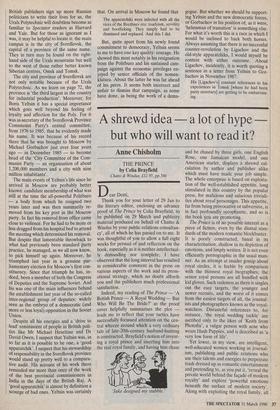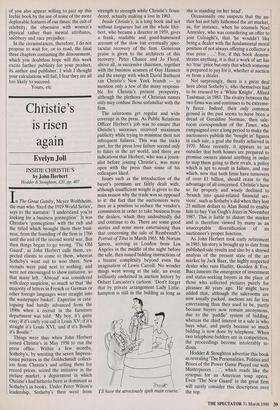A shrewd idea a lot of hype but who will
want to read it?
Anne Chisholm
THE PRINCE by Celia Brayfield Chatto & Windus, £12.95, pp.586 11) ear Dotti, Thank you for your letter of 29 Jan to the literary editor, enclosing an advance proof of The Prince by Celia Brayfield, to be published on 29 March and publicity material produced on behalf of Chatto & Windus by your public relations consultan- cy', all of which he has passed on to me. It was thoughtful of you to allow a full eight weeks for perusal of and reflection on the book, especially as it is neither intellectual- ly demanding nor complete; I have observed that the long interval has resulted in considerable comment in the press on various aspects of the work and its prom- otional strategy, which no doubt affords you and the publishers much professional satisfaction.
Indeed, my reading of The Prince — 'A British Prince — A Royal Wedding — But Who Will Be The Bride?' as the proof cover helpfully summarises the plot leads me to reflect that your tactics have successfully focussed attention on the cen- tral wheeze around which a very ordinary tale of late-20th-century husband-hunting is constructed. Brayfield's notion of invent- ing a royal prince and inserting him into the real royal family, and having him chase Jake designed my stubble.' and be chased by three girls, one English Rose, one Jamaican model, and one American starlet, displays a shrewd cal- culation by author and publisher alike which must have made your job simple. The whole enterprise is based on exploita- tion of the well-established appetite, long stimulated in this country by the popular press, for malicious and salacious triviali- ties about royal personages. This appetite, far from being provocative or subversive, is in fact profoundly sycophantic, and so is the book you are promoting.
The Prince is of no possible interest as a piece of fiction, even by the dismal stan- dards of the modern romantic blockbuster. It is poorly constructed, banal in its characterisation, shallow in its depiction of emotions, and limply written. It is not even efficiently pornographic in the usual man- ner. As an attempt at insider gossip about royal circles, it is feeble by comparison with the thinnest royal biographies; the senior royal persons are all handled with kid gloves. Such rudeness as there is singles out the easy targets, the younger and newer recruits, and the worst of it comes from the easiest targets of all, the journal- ists and photographers known as the royal- watchers. Distasteful references to, for instance, 'the royal wedding tackle' are ascribed only to the likes of 'Keith from Photofix', a vulgar person with acne who wears Hush Puppies, and is described as 'a very low form of life'.
Yet lower, in my view, are intelligent, well-educated women working in journal- ism, publishing and public relations who use their talents and energies to perpetrate trash dressed up as romantic entertainment and pretending to, as you put it, 'reveal the private world behind the façade of modern royalty' and explore 'powerful emotions beneath the surface of modern society'. Along with exploiting the royal family, all of you also appear willing to jazz up this feeble book by the use of some of the more deplorable features of our times: the cult of celebrity, the obsession with women's physical rather than mental attributes, snobbery and race prejudice. In the circumstances, therefore, I do not propose to wait for, or to read, the final three chapters containing the denouement, which you doubtless hope will this week excite further publicity for your product, its author and publisher. I wish I thought your calculations will fail; I fear they are all too likely to succeed.
Yours, etc



























































 Previous page
Previous page